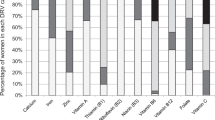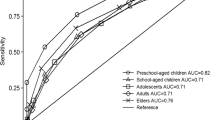Abstract
Background/Objectives:
Low calcium and vitamin D intakes have been associated with health risks in childhood and adulthood. This study aims to investigate dietary sources of calcium and vitamin D intake, and its associated sociodemographic, economic and lifestyle factors among preschoolers.
Subjects/Methods:
Three-day estimated diet records from 696 Flemish preschoolers 2.5–6.5 years old (51% boys) were used (66% of 1052 collected diaries). Contribution of 58 food groups to calcium and vitamin D intake were computed. Multiple linear regression was used to examine associations of intakes with sociodemographic, economic and lifestyle factors.
Results:
Mean calcium intake (844 mg per day) was above, and mean vitamin D intake (2.0 μg per day) largely below the Belgian recommendations. Milk, sweetened milk drinks and cheese were the main sources of calcium intakes (26, 25 and 11%, respectively). Butter and margarine were the main vitamin D sources (26%), followed by growth milk (=fortified milk) (20%) and fish (15%). Calcium and vitamin D intake were negatively associated with participants’ age, and calcium positively with parental education and family size. The child's gender, supplement use and physical activity level, and the employment status and smoking behaviour of the parents were not associated with calcium or vitamin D intake.
Conclusions:
Flemish preschoolers had too low vitamin D intakes while most had adequate calcium intakes. Milk (including sweetened, fortified/growth milk) was the main food source of calcium intake and the second important source of vitamin D intake after butter and margarine. Calcium intake was positively associated with parental education, while vitamin D intake was not.
This is a preview of subscription content, access via your institution
Access options
Subscribe to this journal
Receive 12 print issues and online access
$259.00 per year
only $21.58 per issue
Buy this article
- Purchase on Springer Link
- Instant access to full article PDF
Prices may be subject to local taxes which are calculated during checkout
Similar content being viewed by others
References
Bailey RL, Dodd KW, Goldman JA, Gahche JJ, Dwyer JT, Moshfegh AJ et al. (2010). Estimation of total usual calcium and vitamin D intakes in the United States. J Nutr 140, 817–822.
Davies JH, Evans BA, Gregory JW (2005). Bone mass acquisition in healthy children. Arch Dis Child 90, 373–378.
Davies PS, Bates CJ, Cole TJ, Prentice A, Clarke PC (1999). Vitamin D: seasonal and regional differences in preschool children in Great Britain. Eur J Clin Nutr 53, 195–198.
De Vriese S, Huybrechts I, Moreau M, Van Oyen H (2006). The Belgian Food Consumption Survey 1—2004: report [Enquête de consommation alimentaire Belge 1—2004: Rapport]. Scientific Institute of Public Health: Brussels, Belgium. D/2006/2505/16 (http://www.iph.fgov.be/epidemio/epifr/foodfr/table04.htm).
Emmett P, Rogers I, Symes C (2002). Food and nutrient intakes of a population sample of 3-year-old children in the south west of England in 1996. Public Health Nutr 5, 55–64.
Fox MK, Reidy K, Novak T, Ziegler P (2006). Sources of energy and nutrients in the diets of infants and toddlers. J Am Diet Assoc 106, S28–S42.
FSA (2002). McCance and Widdowson's The Compostition of Foods. Royal Society of Chemistry: Cambridge.
Galobardes B, Morabia A, Bernstein MS (2001). Diet and socioeconomic position: does the use of different indicators matter? Int J Epidemiol 30, 334–340.
Garemo M, Lenner RA, Strandvik B (2007). Swedish pre-school children eat too much junk food and sucrose. Acta Paediatr 96, 266–272.
Guenther PM, Kott PS, Carriquiry AL (1997). Development of an approach for estimating usual nutrient intake distributions at the population level. J Nutr 127, 1106–1112.
Hoge Gezondheidsraad (2003). Dietary Recommendations for Belgium: Revised Version 2003 (Voedingsaanbevelingen voor België: herziene versie 2003). Hoge Gezondheidsraad: Brussels.
Hoge Gezondheidsraad (2009). Dietary Recommendations for Belgium: Revised Version November 2009 (Voedingsaanbevelingen voor België: herziene versie 2009). nr. 8309. Hoge Gezondheidsraad: Brussels.
Huybrechts I, Matthys C, Vereecken C, Maes L, Temme EHM, Van Oyen H et al. (2008a). Food intakes by preschool children in Flanders compared with Dietary Guidelines. Int J Environ Res Public Health 5, 243–257.
Huybrechts I, De Henauw S (2007). Energy and nutrient intakes by pre-school children in Flanders-Belgium. Br J Nutr 98, 600–610.
Huybrechts I, Maes L, Vereecken C, De Keyzer W, De Bacquer D, De Backer G et al. (2010). High dietary supplement intakes among Flemish preschoolers. Appetite 54, 340–345.
Huybrechts I, Matthys C, Pynaert I, De Maeyer M, Bellemans M, De Geeter H et al. (2008b). Flanders preschool dietary survey: rationale, aims, design, methodology and population characteristics. Arch Public Health 66, 5–25.
Iowa State University. C-side. http://www.cssm.iastate.edu/software/cside.html, 2006.
IPL (2004). Table de Composition des Aliments 2004. Institut Paul Lambin: Bruxelles.
Johnston CC, Miller JZ, Slemenda CW, Reister TK, Hui S, Christian JC et al. (1992). Calcium supplementation and increases in bone mineral density in children. N Engl J Med 327, 82–87.
Kalkwarf HJ, Khoury JC, Lanphear BP (2003). Milk intake during childhood and adolescence, adult bone density, and osteoporotic fractures in US women. Am J Clin Nutr 77, 257–265.
Krebs-Smith SM, Kott PS, Guenther PM (1989). Mean proportion and population proportion: two answers to the same question? J Am Diet Assoc 89, 671–676.
Lambert J, Agostoni C, Elmadfa I, Hulshof K, Krause E, Livingstone B et al. (2004). Dietary intake and nutritional status of children and adolescents in Europe. Br J Nutr 92, S147–S211.
Matkovic V (1992). Osteoporosis as a pediatric disease: role of calcium and heredity. J Rheumatol Suppl 33, 54–59.
NEVO (2001). NEVO-Table, Dutch Food Composition Table 2001. NEVO Foundation (in Dutch): Zeist.
NUBEL (2004). Belgian Food Composition Table. 4th edn. Ministry of Public Health (in Dutch): Brussels.
Nusser SM, Carriquiry AL, Dodd KW, Fuller WA (1996). A semiparametric transformation approach to estimating usual daily intake distributions. J Am Stat Assoc 91, 1440–1449.
Rizzoli R, Bianchi ML, Garabedian M, McKay HA, Moreno LA (2010). Maximizing bone mineral mass gain during growth for the prevention of fractures in the adolescents and the elderly. Bone 46, 294–305.
Royo-Bordonada MA, Gorgojo L, de Oya M, Garces C, Rodriguez-Artalejo F, Rubio R et al. (2003). Food sources of nutrients in the diet of Spanish children: the Four Provinces Study. Br J Nutr 89, 105–114.
Serra-Majem L, Ribas-Barba L, Perez-Rodrigo C, Bartrina JA (2006). Nutrient adequacy in Spanish children and adolescents. Br J Nutr 96, S49–S57.
Stellinga-Boelen AA, Wiegersma PA, Storm H, Bijleveld CM, Verkade HJ (2007). Vitamin D levels in children of asylum seekers in the Netherlands in relation to season and dietary intake. Eur J Pediatr 166, 201–206.
Subar AF, Krebs-Smith SM, Cook A, Kahle LL (1998). Dietary sources of nutrients among US children, 1989–1991. Pediatrics 102, 913–923.
Suliga E (2010). Parental education and living environmental influence on physical development, nutritional habits as well as level of physical activity in Polish children and adolescents. Anthropol Anz 68, 53–66.
Tylavsky FA, Cheng S, Lyytikainen A, Viljakainen H, Lamberg-Allardt C (2006). Strategies to improve vitamin D status in northern European children: exploring the merits of vitamin D fortification and supplementation. J Nutr 136, 1130–1134.
Vigez EV (2004). The Active Food Guide Pyramid. Het Vlaams Instituut voor Gezondheidspromotie en Ziektepreventie (VIGeZ): Brussels.
Acknowledgements
We thank all the parents and teachers who participated into this project and generously volunteered their time and knowledge. The Flanders preschool dietary survey was funded by the Belgian Nutrition Information Center (NICE).
Author information
Authors and Affiliations
Corresponding author
Ethics declarations
Competing interests
The authors declare no conflict of interest.
Additional information
Contributors: IH performed and interpreted statistical analyses and drafted the article. YL contributed to the statistical analyses and the interpretation of the results. All other authors helped in the evaluation of the results and the writing of the paper. Moreover, IH and SDH were responsible for the study protocol and the fieldwork. All authors have read and have approved the paper as submitted.
Rights and permissions
About this article
Cite this article
Huybrechts, I., Lin, Y., De Keyzer, W. et al. Dietary sources and sociodemographic and economic factors affecting vitamin D and calcium intakes in Flemish preschoolers. Eur J Clin Nutr 65, 1039–1047 (2011). https://doi.org/10.1038/ejcn.2011.71
Received:
Revised:
Accepted:
Published:
Issue Date:
DOI: https://doi.org/10.1038/ejcn.2011.71
Keywords
This article is cited by
-
A Belgian consensus-statement on growing-up milks for children 12–36 months old
European Journal of Pediatrics (2014)
-
Cross-Sectional Relationship Between Chronic Stress and Mineral Concentrations in Hair of Elementary School Girls
Biological Trace Element Research (2013)
-
Mineral Concentrations in Hair of Belgian Elementary School Girls: Reference Values and Relationship with Food Consumption Frequencies
Biological Trace Element Research (2012)



